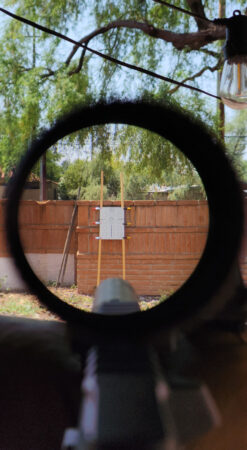The debate between LPVOs, MPVOs, Red Dot + Magnifier, or straight red dot will continue — but today we’re looking at one of the more price-friendly FFP LPVOs on the market, the Swampfox Warhorse 1-6x!
Featuring a 34mm main tube, robust construction, and an MSRP of only $640 this is one of the best (on paper) FFP LPVOs. Does it perform in the field as well as it does on the spec sheet? We had to find out.
SPECS
- Magnification: 1-6x
- Tube Diameter: 34mm
- Objective Lens Diameter: 24mm
- Exit Pupil (mm): 7.7mm-3.7mm
- Eye Relief: 3.43”-3.50” (1x-6x)
- FOV @ 100 Yards: 105.68’-18.32’ (1x-6x)
- Click Value: 0.25 MOA or 0.1 MIL
- Parallax Setting: 100 yds
- Travel Per Rotation: 100 Clicks/25 MOA/10 MIL
- Max Elevation Adjustment: 150 MOA/43.63 MILS
- Max Windage Adjustment: 100 MOA/29.08 MILS
- Lens Coating: Fully Multi-Coated / Anti-fog / Hydrophobic
- Illumination: 12 Position Illumination with intermittent off
- Battery: Side-mounted CR2032 Battery
- Reticle: DRAGOON MOA/MIL
- Fast Focus Diopter: Yes, -2.5 to +2.5
- Turret Style: Push/Pull Locking elevation Turret with Zero Reset and capped windage turret
- Length x Width x Height inches: 10.08” x 2.98” x 2.48”
- Weight: 23.37 oz
- Waterproof Rating: IPX7
- Impact Resistance: 1,100 G Force
FFP Vs. SFP
Like all scopes, LPVOs can come in two flavors — first focal plane and second focal plane. SFP means the reticle stays the same size no matter what level of magnification the scope is at. This means you always have a nice large reticle, but any markings (such as MOA or MIL) inside the reticle are only calibrated at a specific magnification.
FFP is the opposite. The reticle changes size as you move through the magnification range, but at minimum magnification, you’re left with a small reticle while at max magnification the reticle is large.
For long distance shots, FFP is normally better. But FFP is, normally, not great up close because you have a tiny reticle.
Swampfox’s Dragoon reticles solve this with a big horseshoe over top of the MOA/MIL hash marks. At 1x, the horseshoe is large enough to be used as a dot like a red dot would give you. Thankfully, at max magnification, the horseshoe isn’t large enough to get in the way.
ON THE RANGE
It isn’t too often that an LPVO graces my rifles, but with an upcoming class at BRVO Tactical’s Sierra 1 site for the grand opening, it was the perfect time and place to give the Warhorse a run for its money.
For the month leading up to the class and for the class itself, all of my range time was spent learning the Warhorse and seeing what it could do.

The best thing about it is the glass quality. Glass has come a long, long way in just the last few years, and getting this level of clarity, crisp image, and lack of chromatic aberration for the price is mindblowing.
The throw lever is well made, mounts very securely, and is comfortable to actually use. As a scope, the Warhorse does really well.
Square box tracking tests showed the Warhorse to track exactly as expected meaning that dialing for a longer shot is possible. While the reticle has 6 MIL of holdover, if you want to really reach out on a target you might need more and that will take dialing.
On 1x isn’t as good of an experience, mostly due to illumination we’ll take a closer look at in a moment. But even with the not-ideal brightness, close work was at least manageable. While it felt slower and with much less confidence, it was still doable.
Once we moved into the long range areas, things got better as the Warhorse was able to show what good class could do. Unexpectedly, the flat range portion of the class done at 15ish yards was harder than the field conditions 200-400 yard targets.
At 4x to 6x the Warhorse performs outstandingly well. The 6 MILs of holdover was enough to consistently hit the 400 yard torso steel and score a decent hit percentage on the ~530 yard steel. Anything 350 and under was just easy.
Big thanks to TrueShot Ammo for providing me with some PMC 77gr for the class. Having good ammo made reaching out a lot easier, especially when working with a 12.5″ barrel.

When shooting with magnification, I never felt the Warhorse was lacking and me with my rifle and the Warhorse was constantly able to outperform shooters with much more expensive optics.
For durability, while nothing too crazy happened to the Warhorse it was thrown around a HMMWV all weekend, dropped once, and generally treated more like a rented draft mule than a Thoroughbred. The Warhorse came out of it with some scratches, but nothing major and still tracking flawlessly.
Daylight Bright?
Overall the Warhorse has a LOT going for it. The price, the glass, the reticle, the overall quality — all rock solid. But the illumination is where it stumbles.
Direct from Swampfox’s website: “ANYTIME ILLUMINATION. Settings 1-2 are night vision compatible with settings 3-5 optimized for low light. Settings 6-10 are suitable for indoor or overcast lighting, while settings 11 and 12 provide daylight bright illumination.”
I don’t know what basement the illumination is tested in, but it isn’t daylight-bright.
During the class at BRVO Tactical, we spent about 2/3rds of the first day under heavy overcast and thunderclouds. Even at setting 12 on the Warhorse, the illumination was barely acceptable at 1x.
As soon as the clouds thinned down, the scope had at best a green hue to the reticle. And once the clouds rolled out, it was impossible to tell if it was at 12 or not on at all.
At 6x the illumination faired better, but that has more to do with the reticle being larger at 6x. Still, it wasn’t nearly as bright as any other illuminated reticle scope in my inventory.
A fresh battery was loaded for day 2, but it made no difference. A second fresh battery was installed for this picture:

This is one of the problems that FFP LPVOs have in general — they aren’t bright. This is something that is just accepted as one of the shortfalls of an FFP LPVO, however, some other FFP LPVOs are at least a bit better than the Warhorse in this area.
THE BOTTOMLINE
After testing the Swampfox Raider 1x Prism sight, the only fault was the lack of brightness to the optic. This same issue has repeated itself with the Warhorse LPVO. If this is a make-or-break issue for you will depend on where you live, how you shoot, and how much you want a “red dot experience” at 1x for an LPVO.
In my book, FFP LPVOs excel when most of your shooting will be done with magnification. While shots at 1x weren’t ideal, engaging targets at 100-400 yards with magnification was easy and the Warhorse performed excellently.
RIFLE SPECS:
- UTG Pro Ambi Lower Receiver
- Aero Precision Upper Receiver
- Lead & Steel ARC Handguard
- Lead & Steel MonoBloc 12.5″ Barrel
- 5.11 VTAC Sling
- AAC Ranger 5 Suppressor
- Cloud Defensive REIN 3.0
- Walker Defense Research FDE BCG
- KE Arms SLT Gen 2 Trigger
- SB Tactical SBA-3 Brace
- B5 Systems Pistol Grip
- Radian Weapons Ambi Safety
- Breek Arms Warhammer Mod2 Charging Handle
- Strike Industries Forward Stackable Grip And Cable Management Cover
- Swampfox WARHORSE 1-6x FFP LPVO w/ Swampfox LPVO Mount
READ MORE!

NEXT STEP: Download Your Free Target Pack from RECOIL
For years, RECOIL magazine has treated its readers to a full-size (sometimes full color!) shooting target tucked into each big issue. Now we’ve compiled over 50 of our most popular targets into this one digital PDF download. From handgun drills to AR-15 practice, these 50+ targets have you covered. Print off as many as you like (ammo not included).
Get your pack of 50 Print-at-Home targets when you subscribe to the RECOIL email newsletter. We’ll send you weekly updates on guns, gear, industry news, and special offers from leading manufacturers – your guide to the firearms lifestyle.
You want this. Trust Us.
Read the full article here




![Swampfox WARHORSE 1-6x28mm FFP LPVO [Hands-On Review] Swampfox WARHORSE 1-6x28mm FFP LPVO [Hands-On Review]](https://gungravy.com/wp-content/uploads/2024/09/Swampfox-1.jpg)





